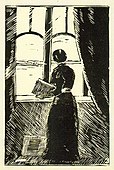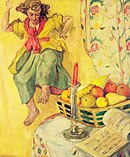Eduard impact
David Eduard Einschlag (born February 28, 1879 in Leipzig ; † May 8, 1945 ) was a German painter and etcher . He is considered one of the main representatives of the Leipzig Impressionists.
Life
Einschlag was born in the trade fair city of Leipzig as the second eldest son of the Jewish accountant Joseph Einschlag (1849–1934) in the residential building at Nürnberger Straße 30. His father was an honorary member of the Leipziger Sing-Akademie and co-founder of the Schubertbund in Leipzig.
Eduard Einschlag attended civil and then commercial school in his hometown. First he worked briefly in the father's company in the commercial field before he went to Ludwig Nieper (1826–1906) to train at the Royal Art Academy and Applied Arts School in Leipzig . After the turn of the century Eduard Einschlag moved to the art academy in Munich, where he studied the art of etching with Peter Halm (1854–1934). He then enrolled at the Prussian Academy of Arts in Berlin, where he became a master student of Karl Köpping (1848-1914).
As early as 1908, a still life by Eduard Einschlag was offered for sale at the Berlin art exhibition. At that time, Einschlag had already moved to Charlottenburg, where he found an apartment at Hardenbergstrasse 33.
In 1909, Einschlag went to Paris for further training. The following year he returned to Leipzig, where he worked from then on. Here he initially lived at Weststrasse 29 (since 1945 Friedrich-Ebert-Strasse). After he married his wife Louise, née Croner (1883–1945), in 1912 the couple moved into an apartment with a studio on the top floor in the Märchenhaus , Thomasiusstraße 28. The painter Rüdiger Berlit (1883–1939) was a neighbor here for over 25 years .
In Leipzig, Einschlag became a member of the Leipzig Secession, the German Association of Artists and co-founder of the Leipzig Annual Exhibition (LIA) , for which he organized several exhibitions.
In 1914 he received the Golden State Medal on the Bugra . In 1926 he took part in the Venice Biennale .
During the time of National Socialism, Eduard Einschlag was exposed to reprisals as a Jew. By law he was now a Polish citizen because of the family origin. In November 1938, the Einschlag couple were deported to the Polish border in railroad cars with other 5,000 Leipzig citizens and lived in the Warsaw ghetto until they were deported . The rest of life is now lost, they were probably murdered in the Treblinka concentration camp . In 1966 both were pronounced dead on May 8, 1945. Stumbling blocks were set for both of them in front of the former home .
Impact pictures were confiscated. In 2008 three paintings, including the self-portrait, and other graphic sheets were returned to his heirs living in Israel from the Leipzig Museum of Fine Arts .
Max Schwimmer (1895–1960) assessed Eduard Einschlag as follows in 1959: “Eduard Einschlag was a leading figure in Leipzig and even in German art life. He had great success as a painter and graphic artist and was considered a stimulating and important personality among artists. The artistic youth adored and admired him. He was a member of the German Association of Artists and was on the board of the LIA (Leipzig Annual Exhibition) founded by Max Klinger. The general director of the Berlin galleries privy councilor Dr. Bode valued his high level of skill and had various masterpieces of 17th century Dutch art made by him using graphic techniques. Einschlag studied in Munich, Berlin and Paris. His murder by the Nazis deeply moved and terrified all decent artists in Leipzig. "
Works (selection)
- Young woman with a cape , etching (1901)
- Russian peasant , etching (1903)
- Female Nude , oil on canvas (1909)
- Portrait of the sculptor Schlosser , charcoal drawing (1909)
- Nude at the armchair , etching (1913)
- Child portrait , charcoal / pastel (1917)
- At the window , woodcut (1918)
- Still life with jugs and fruits , oil on canvas (1924)
- Fruits , oil on canvas (1925)
- Portrait of Karl Sudhoff , oil on canvas (1928)
- Flower still life , oil on canvas (1928)
- Self-portrait , oil on canvas (around 1930)
- Still life with fruits, notes and a baroque angel , oil on canvas (1934)
- Portrait of Barnet Light , pastel painting
- Portrait of Hans Driesch , etching
- Portrait of a man (after Rembrandt) , etching
Image examples
literature
- Impact, Eduard . In: Ulrich Thieme (Hrsg.): General Lexicon of Fine Artists from Antiquity to the Present . Founded by Ulrich Thieme and Felix Becker . tape 10 : Dubolon – Erlwein . EA Seemann, Leipzig 1914, p. 423 ( Textarchiv - Internet Archive ).
- Impact, Eduard . In: Hans Vollmer (Hrsg.): General Lexicon of Fine Artists of the XX. Century. tape 2 : E-J . EA Seemann, Leipzig 1955, p. 24 .
- Hubert Lang: The painter Eduard Einschlag. In: Sächsische Heimatblätter 36, No. 5, 1990, pp. 271-273.
- Renate Hartlieb: Impact, Eduard . In: General Artist Lexicon . The visual artists of all times and peoples (AKL). Volume 33, Saur, Munich a. a. 2002, ISBN 3-598-22773-6 , pp. 14-16.
Web links
- Hubert Lang: Jews in Leipzig. The painter Eduard Einschlag. Retrieved June 13, 2020 .
- About the painter Eduard Einschlag (1879-194?). In: Hans Driesch Science Award. Retrieved June 13, 2020 .
Individual evidence
- ^ Members of the German Association of Artists ( Memento from February 24, 2017 in the Internet Archive ) (accessed June 13, 2020).
- ↑ Eduard Einschlag, No. 15 right
- ^ Hubert Lang: The painter Eduard impact. In: Sächsische Heimatblätter 36, No. 5, 1990, p. 273.
- ↑ Leipzig mayor hand delivers Nazi-era art to painter's heirs , accessed on June 13, 2020
- ^ Jews in Leipzig
| personal data | |
|---|---|
| SURNAME | Impact, Eduard |
| BRIEF DESCRIPTION | German painter and etcher |
| DATE OF BIRTH | February 28, 1879 |
| PLACE OF BIRTH | Leipzig |
| DATE OF DEATH | May 8, 1945 |








